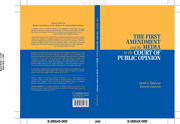Book contents
- Frontmatter
- Contents
- List of Tables and Figures
- Preface and Acknowledgments
- 1 Freedom of the Press and the Power of Public Opinion
- 2 Surveying the Public on Press Freedoms
- 3 What Americans Know About the Freedom of the Press
- 4 Public Support for the Freedom of the Press
- 5 Support for Press Freedoms Across Media: Comparing Print, Electronic, and the “New Media”
- 6 Support for Press Freedoms within a Medium: Elite, Mainstream, and Tabloid News Sources
- 7 Public Opinion, the First Amendment, and the Challenges of the Twenty-First Century
- Appendix: Annotated Questionnaires
- References
- Index
6 - Support for Press Freedoms within a Medium: Elite, Mainstream, and Tabloid News Sources
Published online by Cambridge University Press: 05 June 2012
- Frontmatter
- Contents
- List of Tables and Figures
- Preface and Acknowledgments
- 1 Freedom of the Press and the Power of Public Opinion
- 2 Surveying the Public on Press Freedoms
- 3 What Americans Know About the Freedom of the Press
- 4 Public Support for the Freedom of the Press
- 5 Support for Press Freedoms Across Media: Comparing Print, Electronic, and the “New Media”
- 6 Support for Press Freedoms within a Medium: Elite, Mainstream, and Tabloid News Sources
- 7 Public Opinion, the First Amendment, and the Challenges of the Twenty-First Century
- Appendix: Annotated Questionnaires
- References
- Index
Summary
One would be hard pressed to find two newspapers with more contrasting styles and reputations than the New York Times and the now-defunct Saturday Press of Minneapolis, Minnesota. The former, a nationally recognized institution, has worked hard over the past century and a half to establish its reputation as perhaps the premier “newspaper of record” in the United States. With a daily circulation that numbers in the millions, the Times takes seriously its power to influence political agendas at both the local and national levels. And the Times's editors have long preached adherence to rigorous journalistic standards, ever loyal to the paper's slogan that it publish “all the news that's fit to print.” By contrast, the Saturday Press, first produced during the late 1920s, was considered by many at that time to be a scurrilous and flamboyant newspaper – far more equipped to provoke public outrage than to provide an objective version of the facts. Owned by the racist, anti-Semitic, and anti-Catholic publisher Jay Near, the Saturday Press continually leveled charges of corruption against Minneapolis city leaders. Although often lacking clear evidence to support its accusations, the paper relentlessly attacked local officials, referring to them in many instances as outright “gangsters” (Friendly, 1981). And while many of Near's charges about corruption-ridden Minneapolis turned out to be prophetic, he remained a pariah in his community.
As different as these two newspapers would appear on their face, both played important roles in shaping First Amendment jurisprudence during the past century.
- Type
- Chapter
- Information
- Publisher: Cambridge University PressPrint publication year: 2002

